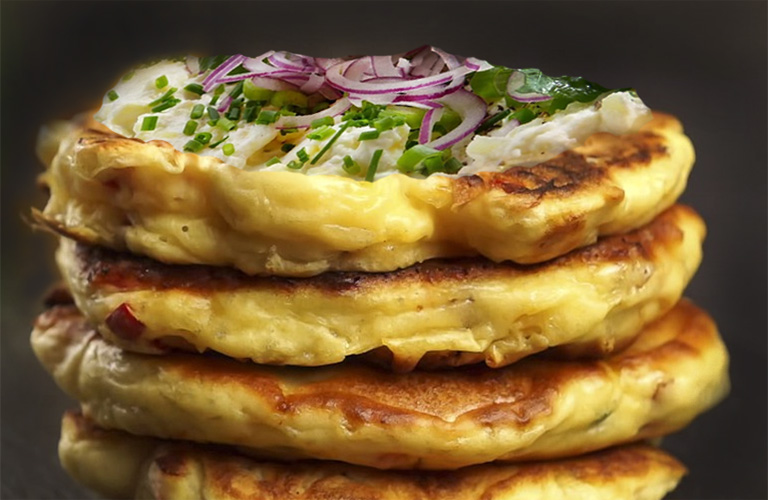Mashed Potato Pancakes
Ingredients:
3 cups chilled mashed potatoes
3/4 cup shredded chedar cheese
2 tablespoons chopped scallions, green and white parts
1 large egg, lightly beaten
3/4 cup all-purpose flour, divided
2 to 3 tablespoons extra virgin olive oil
2 to 3 tablespoons unsalted butter
Sea salt
Garnish:
Sour cream
Chopped or sliced scallions, green and white parts
Sliced red onions, optional
Instructions:
- In large bowl, stir together the mashed potatoes, cheese, scallions, egg and 1/4 cup all-purpose flour until combined (see note). Divide the mixture into 12 portions. Roll each portion into a compact ball, then flatten it into a pancake about 1/2 inch thick.
- Place the remaining 1/2 cup of flour in a shallow dish and carefully dredge each pancake in the flour.
- Heat 2 tablespoons olive oil and 2 tablespoons butter in a large sauté pan over medium heat.
- Fry the pancakes, in batches, until they're golden brown and crispy on both sides, 3 to 4 minutes total. Add more oil and butter to the pan as needed between the batches. (Do not overcrowd the pan, and do not flip the pancakes too soon or they won't develop a crisp crust.) Transfer the pancakes to a paper-towel-lined plate and immediately sprinkle them with sea salt.

To Serve:
- Top potato pancakes with sour cream.
- Sprinkle with chopped or sliced scalions.
- Garnish with slices of red onion, optional.
- Serve warm.
Makes 12 pancakes.
Note: You can use leftover mashed potatoes for this recipe. Keep in mind that leftover mashed potatoes will vary in consistency, depending how much milk, cream, or butter was added to the original batch.
If the the mushed potato pancake mixture looks too dry and isn't holding together, add one more egg. If it looks too wet, add more flour, 1 tablespoon at a time, until the mixture is cohesive.
"What I say is that, if a man really likes potatoes, he must be a pretty decent sort of fellow." ~ A.A. Milne
What You Should Know
When serving food at a buffet, keep food hot with chafing dishes, slow cookers, and warming trays. Keep food cold by nesting dishes in bowls of ice or use small serving trays and replace them often.
Bacteria grow best in the temperature range between 39 °F and 140 °F (4 ºC and 60 ºC). Temperature below 39 °F (4 ºC), and temperature between 140 °F and 165 °F (60 ºC and 74 ºC), will not kill bacteria, but it will not allow them to multiply enough times to cause an illness. In order to kill pathogenic bacteria you need temperatures above 165 °F (74 ºC).
Bacterial intoxication will typically have shorter incubation period than infection (with sudden onset), which usually only lasts one day and fever is rarely present.
Never choose meat or poultry in packaging that is torn or leaking. Do not buy food past "Sell-By," "Use-By," or other expiration dates.
Meat and poultry defrosted in the refrigerator may be refrozen before or after cooking. If thawed by other methods, cook before refreezing.
Discard any food left out at room temperature for more than 2 hours -- 1 hour if the temperature was above 90 °F (32.2 ºC).





